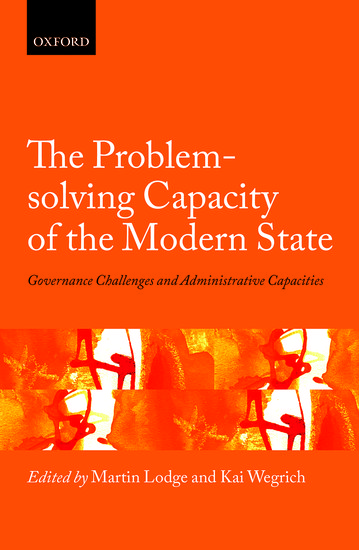Book Review: The Problem-solving Capacity of the Modern State
The early 21st century has presented considerable challenges to the problem-solving capacity of the contemporary state in the industrialised world. Among the many uncertainties, anxieties and tensions, it is, however, the cumulative challenge of fiscal austerity, demographic developments, and climate change that presents the key test for contemporary states. This book considers the state of governance in the current period of profound uncertainty and put forwards a concrete set of proposals for the way ahead. Michael Veale recommends this book to students and scholars whom are interested in what the regulation literature has to say about complex problems.
 The Problem-solving Capacity of the Modern State: Governance challenges and administrative capacities. Martin Lodge and Kai Wegrich (eds). Oxford University Press. October 2014.
The Problem-solving Capacity of the Modern State: Governance challenges and administrative capacities. Martin Lodge and Kai Wegrich (eds). Oxford University Press. October 2014.
The Problem-solving Capacity of the Modern State is an ambitious edited tome which adds to the The Governance Report 2014, a Hertie School of Governance–led initiative to improve and understand governance in a context of messy, changing and contemporary challenges. It is concerned primarily with complex and ‘wicked’ problems including the financial crisis, climate and demographic change, and specifically investigates the role of “administrative capacities as a site of and source for innovative practices” to use when grappling with these emerging and persistent issues.
The editors have channeled considerable thought and effort towards ordering the contributing chapters effectively so that despite their challenging subject matter, the volume’s overall structure is refreshingly coherent.
At first, separate papers look at four ‘administrative capacities’ of the modern state—delivery capacity, coordination capacity, regulatory capacity and analytical capacity. Each chapter is an interesting read in and of itself, but at times they can feel like little islands, with only a fairly infrequent ferry service linking them. The chapter on delivery capacity discusses delegation and collaboration to multiple organisations but lacks strong connections to the chapter on coordination, and there is an underlying feeling that the concept is too strongly linked to public services to also sit comfortably at a larger ‘wicked problem’-scale above the ‘street level’ of the day-to-day antics of bureaucrats. The coordination and analytical chapters have the opposite flavour: the more macroscopic focus on Government with a big ‘g’ makes you wonder if this approach would scale down. This is not to say that these chapters are not explicit about their limitations—more that there is work to be done on what changes about categorised capacities as you scale up and down. The use of advice, for example, is likely to feel very different in a local council compared to at the Cabinet Office.
The next set of chapters considers governance in relation to particular policy areas, namely welfare restructuring in the face of demographic change, issues of sustainability and environment, and the creation and management of public infrastructure. Comparative empirical work is a research priority in the field of governance for complex problems, however this section itself feels like it is lacking in coordination capacity. While the papers themselves are interesting, they feel disjointed and could have benefitted from more of a common structure. At times, it feels like the discussion of capacity was an appended afterthought to other points the authors wanted to prioritise, and in a way this collection is a missed opportunity to begin the carving of a frame for future empirical studies of capacity that one day might allow for more systematic analysis. However this criticism could also be called out as unfair – constructing an approach that is at least somewhat common to problems that have very different features is hardly a straightforward task, and learning what springs to mind when different fields are asked about ‘capacity’ is of interest in itself.

UK Foreign and Commonwealth Office building. (Photo Credit: Foreign and Commonwealth Office. CC-BY.)
The third and final set of chapters look at spaces beyond the traditional state that interface and interplay with capacity and governance innovations. These are mostly transnational by nature—supranational and intergovernmental environments, structures of the European Commission, public-private collaboration, and sustainability certification. This part of the book is especially timely, and in many ways novel, to the fields studying bureaucracies. Whether you believe the state has been ‘hollowed-out’by losing its command-and-control and a mere shell of its former self; or ‘filled-in, orsharper and more focussed in its role as a steering force for a diversity of actors, there is a relative increase in the importance of non-state bodies and their interaction with public servants. Our ideas of greedy bureaucrats or elite and strategic bureaucrats may need reconsidering and refining now that the public sector is more than ever just one actor among many.
This book is easily recommended to students and scholars whom are interested in what the regulation literature has to say about complex problems. This literature is often overlooked in many fields, such as those around the environment and sustainability, yet it comes packaged with a street-level lens that can inform practical advice and insights into how to make day-to-day policy work more effective. Policymakers, however, may find this work less accessible than the accompanying Governance Report, unless they have a social scientific background.
As argued in the final sections of the book, capacity is at its most useful when we look at it with a range of different eyes and when we wear a range of different hats. Marco Verweij’s chapter highlights that even the act of ‘clumsily’ finding better and better approaches to wicked problems has different cultural modes, and that promising ‘polyrational’ approaches have to not only clumsily arrive at a solution, but clumsily mix different clumsy approaches to problem-solving. Delivery, analysis, regulation and coordination are going to look very different and play together in very different ways across cultures and scales. In a way, there is perhaps another capacity—a capacity to both facilitate the emergence of conceptions of success in different policy areas, and to move towards that success by managing and fostering a balance of these capacities across levels and scales of the state’s activities. It is clearly a difficult challenge, and likely requires integrators with wide-ranging and well-developed skills and competences. Better understanding the components of problem-solving lays the important foundation for our urgent mission of trying to navigate to a world where we have become much, much better at it.
—
Note: this post originally appeared on the LSE Review of Books. It gives the views of the authors, and not the position of Democratic Audit UK, nor of the London School of Economics. Please read our comments policy before posting
—
Michael Veale researches science advice to policy at University College London. Previously he has worked in health innovation at the European Commission, and sustainability certification for the sugarcane sector. He has a bachelor’s degree in Government and Economics from LSE and a master’s degree in Sustainability Science and Policy from Maastricht University. His main interests are sustainability at the border of science and policy, private governance and certification, data visualisation, stakeholder participation and innovation.





 Democratic Audit's core funding is provided by the Joseph Rowntree Charitable Trust. Additional funding is provided by the London School of Economics.
Democratic Audit's core funding is provided by the Joseph Rowntree Charitable Trust. Additional funding is provided by the London School of Economics.
The public sector often overlooks analytical capability: Review of The Problem-solving Capacity of the Modern State https://t.co/VC4qesGPap
Book Review: The Problem-solving Capacity of the Modern State: The early 21st century has presented considerab… https://t.co/HIJrAxHQ0s
Book Review: The Problem-solving Capacity of the Modern State https://t.co/eR3snEpXH5 #Option2Spoil
Book Review: The Problem-solving Capacity of the Modern State https://t.co/2knMRw7ert
Book Review: The Problem-solving Capacity of the Modern State https://t.co/7suIOCUz20 https://t.co/Z1n81YyYJO